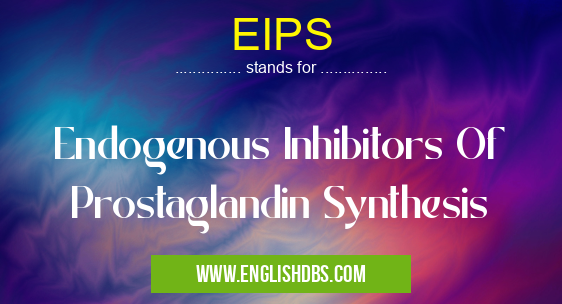What does EIPS mean in UNCLASSIFIED
EIPS stands for Endogenous Inhibitors of Prostaglandin Synthesis. These are naturally occurring chemicals in the human body which have an inhibitory effect on the production of prostaglandins. Prostaglandins are hormones that are responsible for many physiological processes including inflammation, blood flow and regulation of the immune system. The EIPS have an important role to play in maintaining normal physiological homeostasis and thus preventing several diseases.

EIPS meaning in Unclassified in Miscellaneous
EIPS mostly used in an acronym Unclassified in Category Miscellaneous that means Endogenous Inhibitors Of Prostaglandin Synthesis
Shorthand: EIPS,
Full Form: Endogenous Inhibitors Of Prostaglandin Synthesis
For more information of "Endogenous Inhibitors Of Prostaglandin Synthesis", see the section below.
What Are EIPS?
Endogenous Inhibitors of Prostaglandin Synthesis (EIPS) are molecules produced by several cells in the human body including adipocytes, macrophages and platelets. They act as a natural mechanism to limit the synthesis of prostaglandins from arachidonic acid. This helps to maintain normal physiological homeostasis by moderating certain inflammatory reactions and responding to pathogenic stimuli in a way that protects tissues from damage caused by excessive prostaglandin production.
How Do EIPS Work?
EIPS work by blocking the action of enzymes involved in the production of prostaglandins, such as cyclooxygenase (COX) enzymes, phospholipase A2 (PLA2), leukotriene-A4 hydrolase (LTA4H), 5-lipoxygenase (5-LOX) and 12-lipoxygenase (12-LOX). By doing so, these inhibitors can help regulate inflammation, protect cells from damage caused by oxidative stress, modulate blood clotting and even control proliferation or apoptosis of certain cell types.
Benefits of EIPS
Eliminating excessive levels of prostaglandins produced by COX enzymes is one key benefit associated with using EIPS as these hormones can cause pain, especially when they accumulate at sustained levels in damaged tissues due to an injury or disease. Other potential benefits include reducing tissue damage caused by severe inflammation or oxidative stress, modulating platelet aggregation to reduce risk for thrombosis and controlling T-cell activity related to autoimmunity or allergies. Furthermore, it has been suggested that some forms of EIPS may also be beneficial in treating certain cancers due to their ability to inhibit tumor growth through various mechanisms such as regulating cell cycle progression or inducing apoptosis.
Essential Questions and Answers on Endogenous Inhibitors Of Prostaglandin Synthesis in "MISCELLANEOUS»UNFILED"
What are Endogenous Inhibitors of Prostaglandin Synthesis (EIPS)?
Endogenous Inhibitors of Prostaglandin Synthesis (EIPS) are compounds that occur naturally within the body, which inhibit the production of prostaglandins. Prostaglandins act as hormones, and serve various functions including mediating inflammation and pain. EIPS thus serve to decrease inflammation in tissues.
How do Endogenous Inhibitors of Prostaglandin Synthesis (EIPS) work?
EIPS work by binding to prostaglandin synthase enzymes, preventing them from producing prostaglandins. This reduces the levels of prostaglandins in the body, decreasing inflammation and any associated pain or discomfort.
Are Endogenous Inhibitors of Prostaglandin Synthesis (EIPs) found in all organisms?
Yes, EIPs have been identified in all organisms studied so far, from single-celled organisms to mammals and humans. The exact form these inhibitors take may vary based on species.
What is the role of EIPs in healthy tissue?
EIPs play an important role in maintaining healthy tissue because they help reduce inflammation and regulate pain levels. This ensures that organs remain healthy and functioning properly without being subjected to excessive stress caused by inflammation or pain signals.
Are there different types of EIPs for different types of prostaglandins?
Yes, there are many different types of EIPs that can target specific types or classes of prostaglandins depending on their chemical structure and function. Depending on what type(s) of prostaglandins need to be regulated, different types or combinations of EIPs might be used for effective inhibition.
Is it possible to induce a higher production rate of endogenous inhibitors?
Yes, it is possible to induce a higher production rate using certain drugs or supplements known as ‘prostacycline analogues’ which can stimulate the production and release of natural inhibitors within the body. However this should only be done under medical direction as some drugs may be contraindicated with certain health conditions or other medications/supplements.
Can prescription medications be used as endogenous inhibitors?
Some prescription medications such as nonsteroidal anti-inflammatory drugs (NSAIDs) can act as endogenous inhibitors by inhibiting cyclooxygenase enzymes involved in prostaglandin synthesis. However due to potential side effects associated with long term use, such drugs should only be taken upon medical advice for short periods when necessary.
How has research into EIPs progressed over time?
Research into EIPs has advanced significantly over recent years with new discoveries made regularly regarding their biological function and potential therapeutic applications for their use in treating inflammatory diseases such as arthritis and chronic pain conditions.
EIPS also stands for: |
|
| All stands for EIPS |
